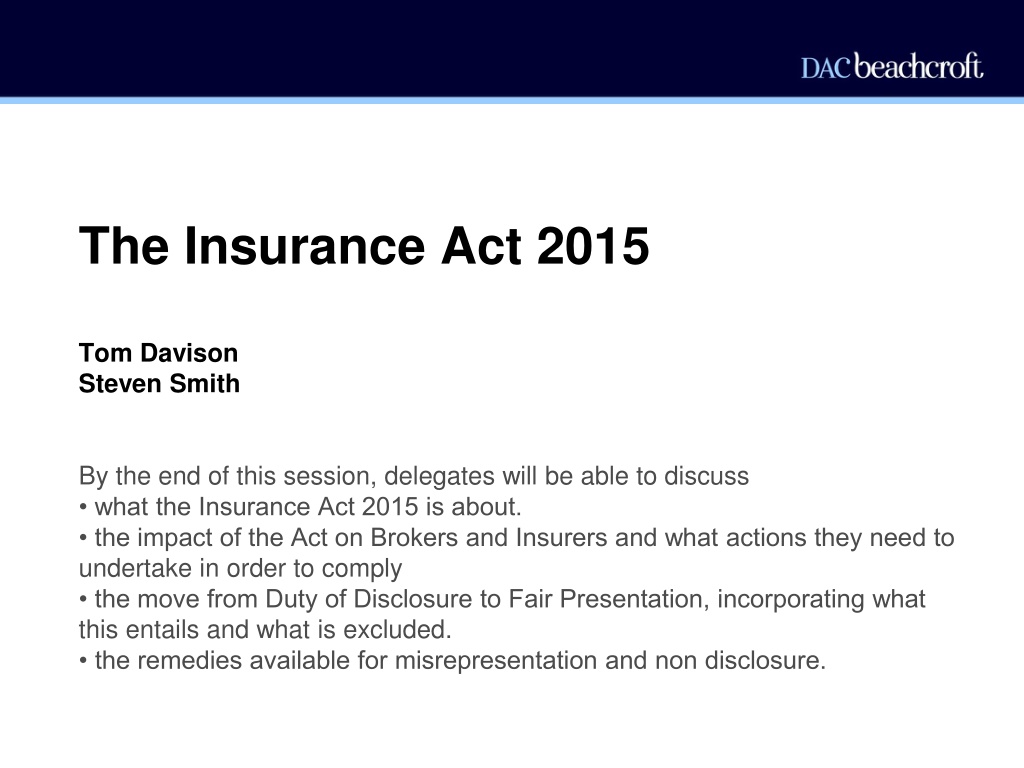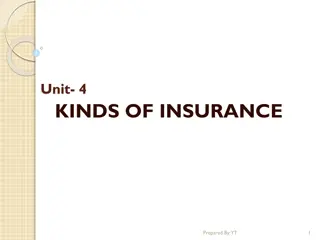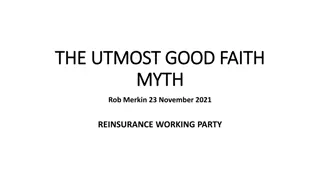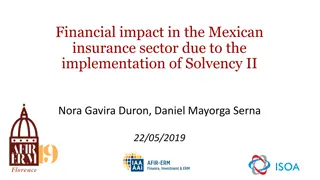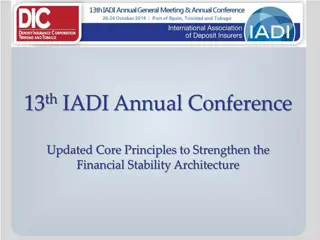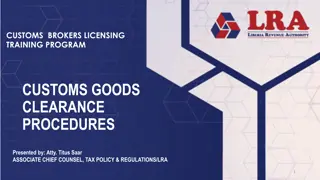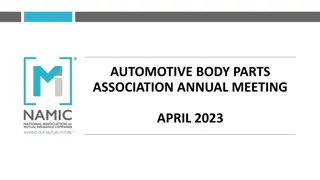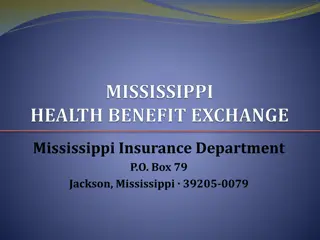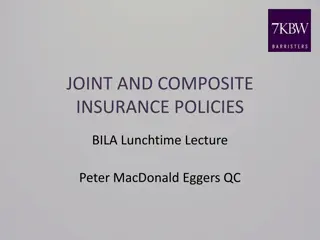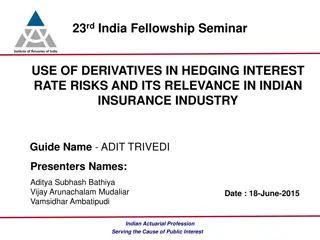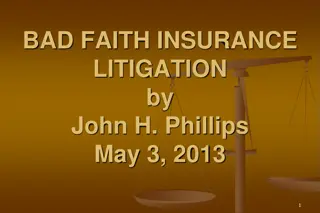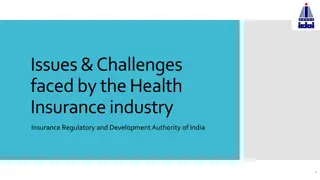Understanding the Impact of the Insurance Act 2015 on Brokers and Insurers
The Insurance Act 2015 brings significant changes in insurance contract law, shifting from Duty of Disclosure to Fair Presentation. This Act influences both Brokers and Insurers, requiring clear and accessible disclosure of material circumstances. The remedies for misrepresentation and non-disclosure are outlined under this Act, emphasizing fair risk presentation. The session covers the implications of IA 2015 and the necessary actions for compliance.
Download Presentation

Please find below an Image/Link to download the presentation.
The content on the website is provided AS IS for your information and personal use only. It may not be sold, licensed, or shared on other websites without obtaining consent from the author. Download presentation by click this link. If you encounter any issues during the download, it is possible that the publisher has removed the file from their server.
E N D
Presentation Transcript
The Insurance Act 2015 Tom Davison Steven Smith By the end of this session, delegates will be able to discuss what the Insurance Act 2015 is about. the impact of the Act on Brokers and Insurers and what actions they need to undertake in order to comply the move from Duty of Disclosure to Fair Presentation, incorporating what this entails and what is excluded. the remedies available for misrepresentation and non disclosure.
Introduction Product of long-running Law Commission review into insurance contract law Existing law perceived as being too insurer-friendly and out of date: Poorly understood Too onerous on insureds (especially in large companies) Problem of data dumping Insurers can play a passive role (underwriting at the claims stage) Remedy (avoidance) is all or nothing Two pieces of legislation to emerge: Consumer Insurance (Disclosure & Representations) Act 2012 ( CIDRA 2012 ) Insurance Act 2015 ( IA 2015 )
Damages for late payment Included within Enterprise Bill Common law No damages for late payment of damages Sprung v Royal Insurance (1996) New implied term that insurer will pay any sums due within a reasonable time BUT Insurer not responsible for delays caused by insured Insurer has an express wrong but reasonable refusal defence Damages subject to foreseeability test
Duty of disclosure: existing law An insured must disclose every material circumstance which it knows or ought to know A material circumstance is one which would influence the judgment of a prudent insurer in fixing the premium or determining whether to take the risk Where a broker is involved, the insured's duty of disclosure is extended to include every material circumstance which the broker knows or ought to know in the ordinary course of business The only remedy for material non-disclosure or misrepresentation is avoidance of the contract of insurance
Duty of disclosure under IA 2015 Duty to give a fair presentation of the risk (s.3(1)): Disclosure must be reasonably clear and accessible (s.3(3)(b)). Disclosure of every material circumstance that the insuredknows or ought to know (s.3(4)(a)), except: Matters which the insurer knows or ought to know (s.3(5)(b)-(d)) Where sufficient information provided to put a prudent insurer on notice that it needs to make further enquiries (i.e. signposting of material facts) (s.3(4)(b)). Material representations must be substantially correct or, if a statement of expectation or belief, given in good faith (s.3(3)(c)). A modern restatement of existing law incorporating developments (Container Transport v Oceanus Mutual (1984). NB: Guidance as to what is material contained in Section 7 of the IA 2015.
Duty: reasonably clear and accessible Data dumping no longer acceptable Insured required to structure, index and signpost the information given Risk effectively shifted onto brokers Key is asking right questions and suggesting sensible ways of organising data
Duty: insured knows or ought to know Knowledge of: Senior management Those responsible for the insurance (including brokers) A reasonable search of information available to the insured required (s.4(6)): Computer records Individuals Outside advisors
Exception: insurer knows / ought to know Knowledge of any persons who play a meaningful role in the underwriting decision Information which is common knowledge (e.g. Hales v Reliance (1960)) No presumption of knowledge simply because insurer had the means of ascertaining that knowledge (Kingscroft v Nissan (1994)) BUT insurer deemed to know information which is held and which is readily available to underwriters (s.5(2)(a))
Exceptions: signposting Insured must try to give good disclosure and provide at least a good base on which insurers can make further enquiries Insurer must engage with the material and ask questions where appropriate
Example: X & Co (1) X & Co takes out product liability insurance, describing itself on the proposal form as a maker of "valves". The insurer does not ask further questions. In fact, the valves are used in the petrochemical industry. A valve fails, leading to a massive explosion at a petrochemical plant and subsequently a large claim.
Case study: X & Co (2) High-risk nature of petrochemical industry is a material circumstance . X & Co failed to disclose that material circumstance. They also failed to signpost the fact by disclosure of relevant information (e.g. manufacture of specialist valves; or manufacture of valves for BASF or ExxonMobil). X & Co therefore in breach of duty of disclosure.
Remedies: current regime Only remedy is avoidance Three stage test in Pan Atlantic v Pine Top (1995): Misrepresentation / non-disclosure Materiality Inducement
Remedies under the IA 2015 Section 8(1) of the IA 2015 provides remedy where there is: Breach of duty of fair presentation; and Inducement Remedy depends on nature of breach: Deliberate or reckless? or Not deliberate or reckless?
Remedies: deliberate or reckless Common law standard of recklessness: indifference to the truth, the moral obliquity of which consists in a wilful disregard of the importance of the truth (Angus v Clifford (1891) Remedy is avoidance
Remedies: neither deliberate nor reckless Careless or inadvertent Remedy depends on what insurer would have done but for breach: No contract = avoidance Different terms = treat as if those terms apply Higher premium = reduce claim proportionately
Warranties: existing regime A promise by the insured which, if broken, discharges the insurer from liability from date of breach 4 problems: Trivial breaches (AXA v Bennett (2003)) No defence to remedy breach Breaches unconnected to loss Basis clauses (Genesis Housing (2013))
Warranties under the IA 2015 Basis clauses no longer permitted (s.9(2)) Warranties now suspensive conditions Regime for terms that seek to diminish the risk of a particular loss
Terms that seek to diminish the risk Need to show increase in risk, not a causal connection Risk judged at the point of non-compliance, so before the insured event (O Connor v Bullimore (2004))
Any Questions? You should now be able to discuss: what the Insurance Act 2015 is about. the impact of the Act on Brokers and Insurers and what actions they need to undertake in order to comply the move from Duty of Disclosure to Fair Presentation, incorporating what this entails and what is excluded. the remedies available for misrepresentation and non disclosure. Tom Davison, Associate Tel: + 44 (0) 121 698 5414 Email: tdavison@dacbeachcroft.com Steven Smith, Solicitor Tel: + 44 (0) 121 698 5185 Email: sdsmith@dacbeachcroft.com
